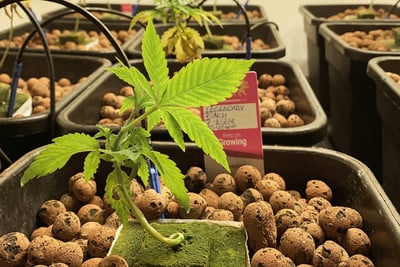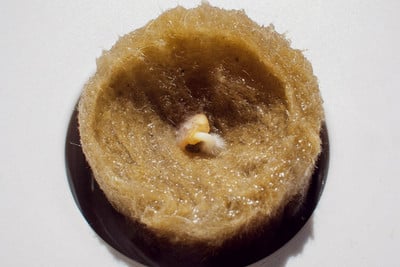 Weed Grow Guide by Royal Queen Seeds
Weed Grow Guide by Royal Queen Seeds
- Growing weed step by step
- Cannabis growing basics
- Choosing your seeds
- How to germinate seeds
- The cannabis vegetative stage
- The cannabis flowering stage
- Harvesting cannabis
- Trimming, drying, and curing
- Choosing pots and soil
-
Growing indoors
- A Complete Overview Of Growing Cannabis Indoors
- Cannabis Cultivation Tips: How To Set Up Indoor Grow Lights
- How Many Cannabis Plants Can You Grow Per Square Metre?
- Indoor Cannabis Growing: Relative Humidity and Temperatures
- Hydroponics Cannabis Growing Guide (with diagrams)
- Cannabis Micro Growing: Growing Great Weed in Tiny Spaces
- Growing outdoors
- How to grow autoflowering cannabis
- Cannabis nutrients and pH
- Cannabis troubleshooting: Nutrients
-
Cannabis troubleshooting: Growing
- Cannabis Seed Germination — Troubleshooting Guide
- How to Deal With Pythium (Root Rot) in Cannabis Plants
- Slow Cannabis Plant Growth And What You Can Do About It
- How to Prevent and Fix Stretching in Cannabis Seedlings
- Watering Your Cannabis: How to Fix Overwatering and Underwatering
- Understanding Male, Female, And Hermaphrodite Cannabis
- Identifying and Treating Common Cannabis Ailments
- How To Revive a Sick Cannabis Plant
- How to Avoid Mouldy Weed During Drying and Curing
- How to Prevent and Treat Dry and Crispy Cannabis Leaves
- What Cannabis Leaves Can Tell You
- Causes and Solutions for Yellow Cannabis Leaves
-
Cannabis Strains Grow Report
- HulkBerry Automatic Grow Report
- Blue Cheese Auto Grow Report
- Purple Punch Automatic Grow Report
- Triple G Automatic Grow Report
- Do-Si-Dos Automatic Grow Report
- Green Gelato Automatic Grow Report
- Haze Berry Automatic Grow Report
- Purple Queen Automatic Grow Report
- Cookies Gelato Automatic Grow Report
- Sherbet Queen Automatic Grow Report
- Sweet Skunk Automatic Grow Report
- Medusa F1 Grow Report
- Cannabis plant training
-
Weed growing tips
- The Cannabis Plant Anatomy
- How to preserve seeds
- How Much Sunlight Do Outdoor Cannabis Plants Need To Grow?
- How to Control and Prevent Stretching in Cannabis Plants
- My Cannabis Plants Are Growing Too Tall: What Should I Do?
- Should You Worry About Purple Or Red Cannabis Stems?
- What To Do When Your Indoor Cannabis Won’t Flower
- How To Protect Your Cannabis Plants From Heat Stress
- How To Tell If Your Female Cannabis Plant Has Been Pollinated
- Growing Medical Marijuana
- Bud Washing: How to Clean Your Weed
- Understanding Cannabis Yield per Plant

Hydroponics Cannabis Growing Guide (with diagrams)
Contents:
- The history of hydroponics
- The advantages of hydroponic growing
- What’s the difference between active and passive hydroponics?
- Passive hydroponic systems for weed
- Active hydroponic systems for weed
- The cost of growing with hydroponics
- Materials needed to make a diy hydroponic system
- Choose a growing medium to get things started
- Choose a hydroponic growing setup for your plants to thrive in
- Prepare your system to ensure a successful grow
- Hydroponics can be intimidating, but the reward is worth it
As the name may suggest, hydroponics is a soilless method of growing cannabis using water as the primary medium. Within a hydroponic setup, cannabis plants are grown in buckets or baskets filled with an inert growing medium, and are suspended over a tank full of water. The water is filled with all of the nutrients plants need to survive and thrive, and air stones are used to aerate the tank. This basic model manifests in many different forms and systems, with different growers preferring different setups. There are many advantages to hydroponic cultivation, all of which will be covered in this article. But first, let's delve into the history of this fascinating art form.
The History of Hydroponics
Hydroponic cultivation might initially seem like the result of modern advances in technology. But this couldn’t be further from the truth. The origins of growing plants in water goes back thousands of years into human history. The famous Hanging Gardens of Babylon, created in 600 BCE, are theorised to have utilised hydroponic principles. The region located next to the Euphrates was naturally dry and arid. It’s believed the crops of the garden were nurtured using a trickle-system starting at the river.
Moving closer in time to the 10th and 11th centuries, the Aztec civilisation was also known to utilise hydroponics to provide sustenance to their society. After being forced from their land via conflict, these people settled at Lake Tenochtitlan. They proceeded to build floating rafts topped with soil, allowing crops to grow through the tap layer and spread their roots into the waters below.
More recent, but still distant, examples of hydroponic growing involve the English scientist John Woodward in 1699. His work involved cultivating spearmint plants in water. He found that the plant species grew faster within a water source mixed with soil.

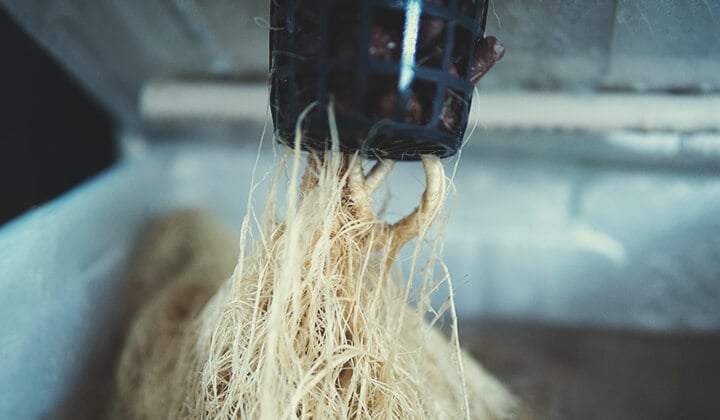
The Advantages of Hydroponic Growing
If you talk to a grower who has experience with hydroponic growing, one of the first things they’ll probably tell you is that their hydroponic plants grow much, much faster than those in soil. This is a prime advantage of this method of cultivation—hydroponic plants usually grow 30–50% faster and often provide larger yields. A large reason for this is that nutrients within a hydroponic system are much more readily available to plants. The nutrients are suspended in water and enter directly into the root system as there is no soil to navigate through. In contrast, plants growing in soil must search through the medium in order to uptake nutrients from below. Easy access to nutrients allows plants to preserve energy, which is then diverted to growth efforts instead.
What’s the Difference Between Active and Passive Hydroponics?
Hydroponic systems are either active or passive, depending on the way they are designed. Active systems involve the movement of nutrient solution using electric pumps and the oxygenation of water using air stones. Passive systems are much more simple, and some rely on capillary action instead of electric pumps to deliver nutrient solution.
Passive Hydroponic Systems for Weed
Passive hydroponic systems feature minimalist designs. They use low-tech methods to deliver water and nutrients to cannabis roots without using additional electricity.
Types of Passive Hydroponic Systems
There are numerous types of passive hydroponic systems, but the Kratky method and wick system are two of the most popular.
| The Kratky Method | The Wick System |
| The Kratky Method | The Wick System |
Benefits of Passive Hydroponic Systems
Passive hydroponic systems are simple and easy. They serve as a great introduction to this water-based way of growing, and are cheaper than active alternatives. The main benefits of passive systems are:
✔️Inexpensive
✔️Easy to set up
✔️Great for beginners
✔️Less electricity required
Is Passive Hydroponics Better Than Hand Watering?
It depends on what system you’re using. Kratky systems don’t require any hand watering at all. Wick systems that use soil are often superior to hand watering, as the slow and steady delivery of water into the medium helps to reduce overwatering. However, they sometimes fail to provide enough water to large and thirsty plants, meaning growers may need to occasionally intervene with a watering can.
Active Hydroponic Systems for Weed
Active hydroponic systems harness the power of modern innovations to keep plants fed, watered, and aerated. They use electric air pumps and air stones to provide cannabis roots with all the ingredients needed to support a healthy plant. Because they utilise electronic devices, growers can choose to automate these systems to reduce their workload.
Types of Active Hydroponic Systems
If you’re drawn to active hydroponic systems, you have plenty of options to choose from.
| Deep Water Culture | Ebb and Flow |
| Nutrient Film Technique | Drip System |
| Aeroponics |
| Deep Water Culture | Ebb and Flow | Nutrient Film Technique | Drip System | Aeroponics |
Benefits of Active Hydroponic Systems
Active hydroponic systems work well for larger growing operations. Despite their vulnerability to power outages, they offer the following benefits:
✔️Water-efficient
✔️Provide plenty of oxygen
✔️Easy to automate
The Cost of Growing with Hydroponics
When thinking about hydroponics, you might picture a high-tech setup: automated switches, flashing lights, ticking timers. However, the cost of a hydroponic system all depends on how much money you’re willing to splash. They range from a simple plastic bucket all the way to self-draining and flooding systems. To save time, invest in a cheap hydroponic starter kit. These include all of the materials you need to get from seed to harvest. You can purchase one for around £200 (€235).
Materials Needed to Make a DIY Hydroponic System
If you go the DIY route, check out the brief guide below. The list covers all of the equipment you need to construct a basic indoor setup. Simply find the product that suits you for each listed item. Buying your gear separately allows you to invest more heavily into important items such as lighting while reducing the cost in other areas.
Here’s what you’ll need:
| a) Lighting (LED or HPS) | h) Seeds |
| b) Lighting hangers | i) Ventilation fan and ducting tubes |
| c) Grow tent | j) Carbon filter |
| d) Hydroponic reservoir and tray | k) Oscillating fan |
| e) Airstone and pump | l) Hydroponic nutrients |
| f) Growing medium (e.g. coco coir) | m) pH and TDS/EC meters |
| g) Net mesh planting pots | n) Thermometer/Hygrometer |
b) Lighting hangers
c) Grow tent
d) Hydroponic reservoir and tray
e) Airstone and pump
f) Growing medium (e.g. coco coir)
g) Net mesh planting pots
h) Seeds
i) Ventilation fan and ducting tubes
k) Oscillating fan
m) pH and TDS/EC meters
n) Thermometer/Hygrometer

1. Choose a Growing Medium to Get Things Started
Now that we have covered the history and benefits of hydroponic growing, it’s time to get things started. To begin, you’ll need to select a growing medium—a substance that will hold in place the intersection of the stem and roots. From this location, the roots will grow down into the water in search of nutrients. The inert medium also allows good air access to the top of the roots. There is a huge list of different media used by cultivators, with those below being the most common. Each medium has its own unique benefits, and some work better with different systems. It’s all about experimentation when starting out to see which works best for you.
-
Clay Pebbles

As one of the most popular options, clay pebbles are excellent at aerating root systems. Clay pebbles sometimes require that growers alter the pH in order to provide an optimal growing environment, however, pre-altered pebbles can be purchased. You’ll need to place clay pebbles into a plastic hydroponic basket that has spaces for roots to grow through.

As one of the most popular options, clay pebbles are excellent at aerating root systems. Clay pebbles sometimes require that growers alter the pH in order to provide an optimal growing environment, however, pre-altered pebbles can be purchased. You’ll need to place clay pebbles into a plastic hydroponic basket that has spaces for roots to grow through.
-
Rockwool

Rockwool is another popular choice, and is a substance created using volcanic rocks with a wool texture, hence the name. Rockwool has a tremendous capacity to retain water, which allows for good hydration of the upper root system. Rockwool can be placed within a hydroponic basket, but can also be lodged directly into the top of a bucket or tank lid without.

Rockwool is another popular choice, and is a substance created using volcanic rocks with a wool texture, hence the name. Rockwool has a tremendous capacity to retain water, which allows for good hydration of the upper root system. Rockwool can be placed within a hydroponic basket, but can also be lodged directly into the top of a bucket or tank lid without.
-
Perlite

Perlite is a volcanic glass that expands when exposed to high temperatures. It’s often used in garden soils to provide aeration, which is exactly why it's beneficial to use as a hydroponic growing medium for cannabis.

Perlite is a volcanic glass that expands when exposed to high temperatures. It’s often used in garden soils to provide aeration, which is exactly why it's beneficial to use as a hydroponic growing medium for cannabis.
-
Coco Coir

Coco coir is a good sustainable option for a growing medium. As the fibre from coconuts, coco coir allows for good aeration and moisture retention. Coconut fibres are also known to protect roots from infection due to the presence of plant-stimulating hormones.

2. Choose a Hydroponic Growing Setup for Your Plants to Thrive In
Now that you’ve selected a growing medium, it’s time to choose which type of hydroponic setup to use. All systems are similar in that they utilise a nutrient-enriched water solution. However, setups can vary widely depending on factors such as water exposure and circulation. Most of the following systems can be purchased, but those with DIY skills could easily make them by using buckets, drills, pumps, and air stones.
-
The Kratky Method – Diagram
The Kratky method makes hydroponic growing affordable, accessible, and easy. Growers can use a range of items to make these systems, including buckets and plastic boxes. The plants sit in net cups inserted into a lid, and the roots reach down into a nutrient solution below.
A gap of air between the surface of the solution and the bottom of the lid aerates the upper roots. This provides oxygen to the root system and removes the need for an air stone. The roots continue to grow down into the solution as the level reduces. Growers just need to make sure they top up their containers before their plants drink up all the fluid.
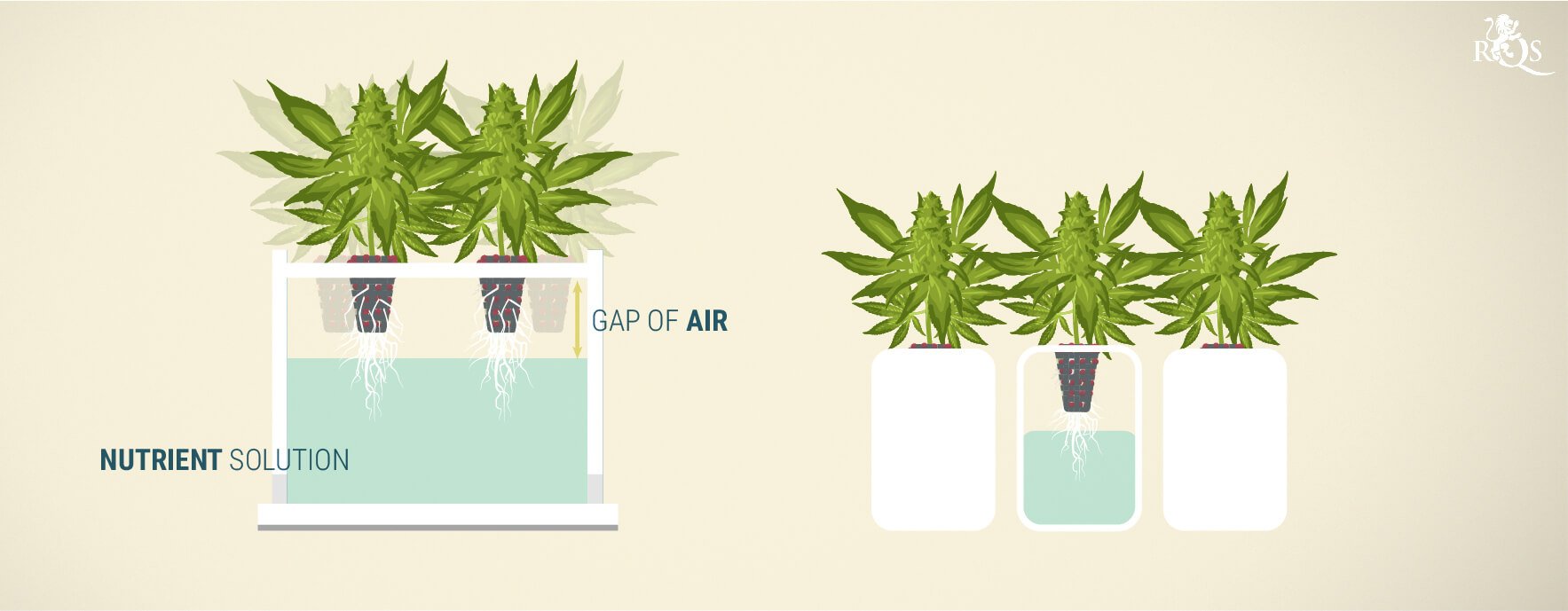

-
Deep Water Culture – Diagram
Deep water culture systems are effectively active versions of Kratky systems. They feature a single reservoir filled to the top with nutrient solution. Plants sit in net cups that are slotted into holes in a Styrofoam sheet that floats on the surface. Unlike the Kratky method, deep water culture systems don't need to maintain an air gap to allow the upper roots to breathe. Instead, the system uses an air stone to continually aerate the solution.
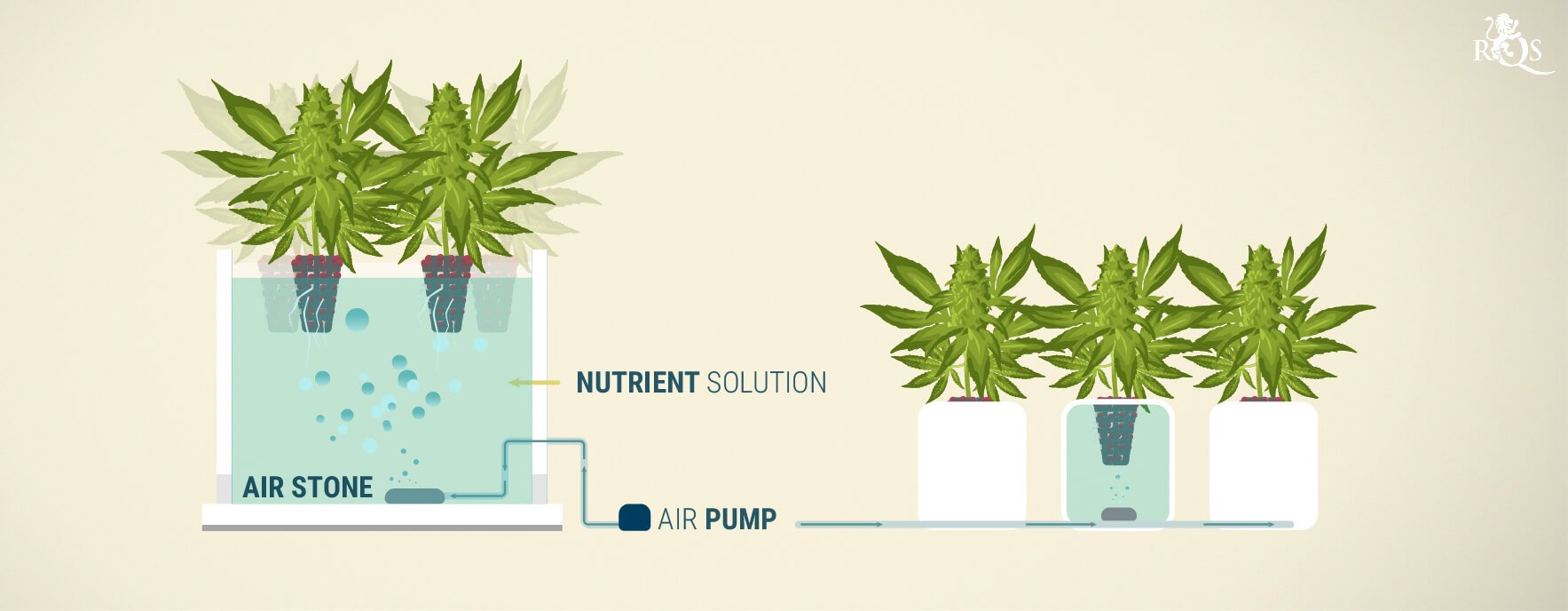
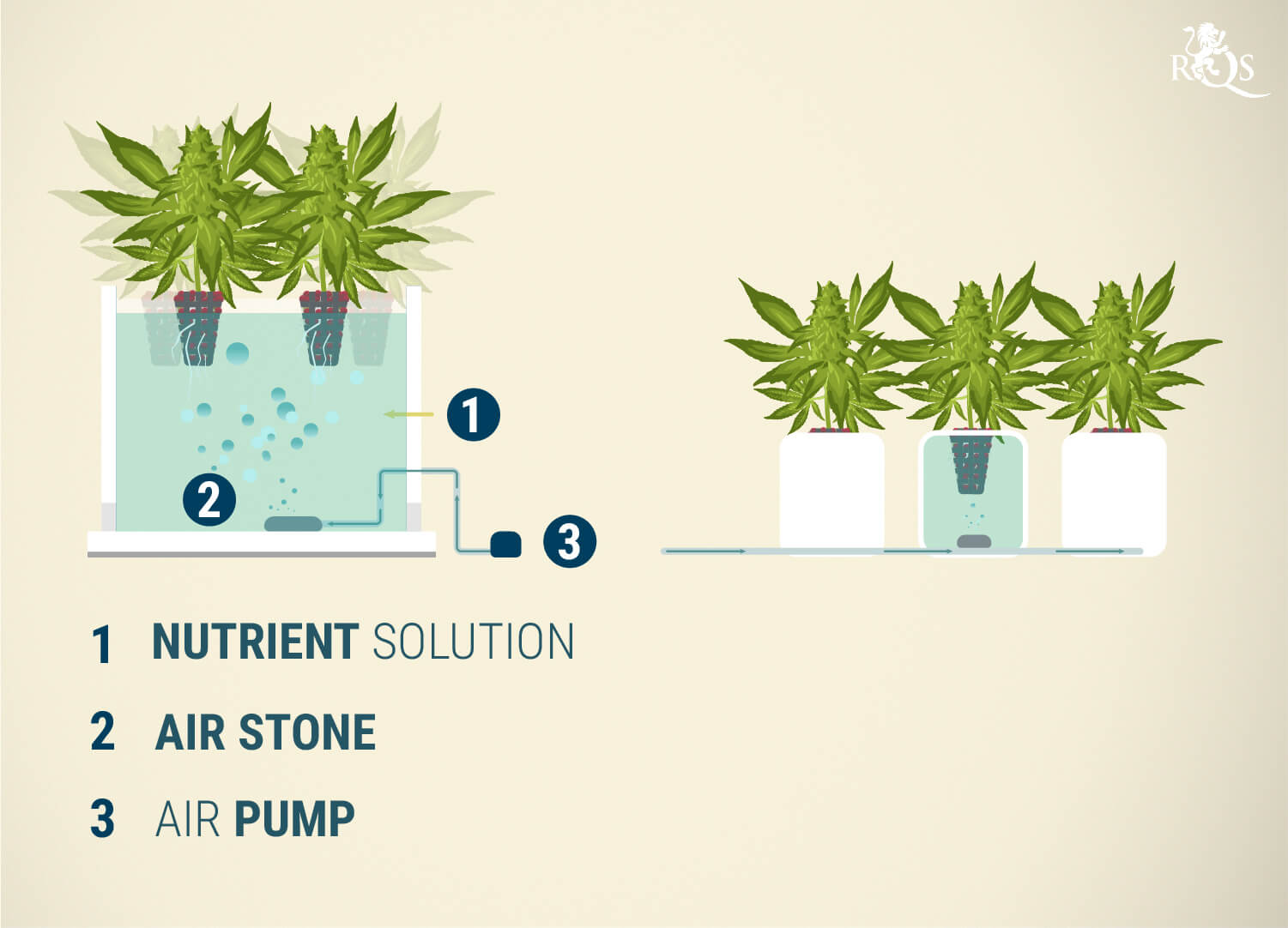
-
Ebb and Flow – Diagram
An ebb and flow (also known as flood and drain) system features water that, well, ebbs and flows. These systems consist of several buckets suspended above a growing tray that features a water inlet and outlet. Both of these waterways are connected to an external tank that contains nutrients, an air stone to aerate the water supply, and a pump to move water into the growing tray. The roots in these systems are not continuously submerged within water. Instead, water periodically floods the growing tray with fresh oxygen and nutrient-enriched water. Once the pump cycle ends, all of the water drains back into the external tank.
This system allows for periodic feeding. The time when the growing tray is empty allows growers to easily tend to plant roots and harvest plants.

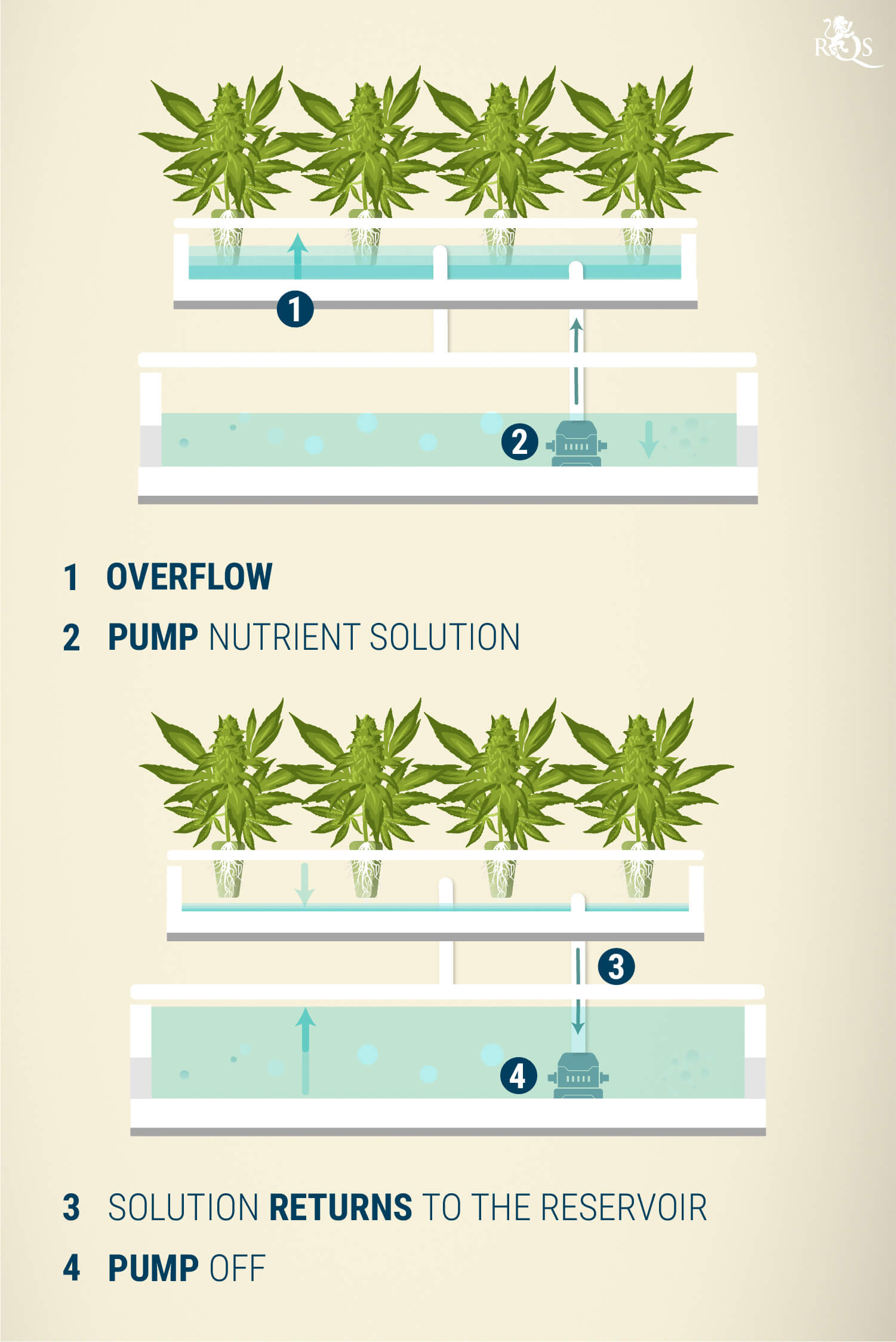
-
Drip System – Diagram
A drip system in hydroponics is very similar to a drip irrigation system when growing in soil. This system consists of a large tray filled with growing medium, such as clay pebbles. Plants are placed directly into the medium, and each has its own drip pipe nearby. An external water tank with a pump and air stones constantly supplies a drip feed of water over each plant. The roots of these plants are constantly exposed to air, and the excess water drips down the medium and back into the external tank.

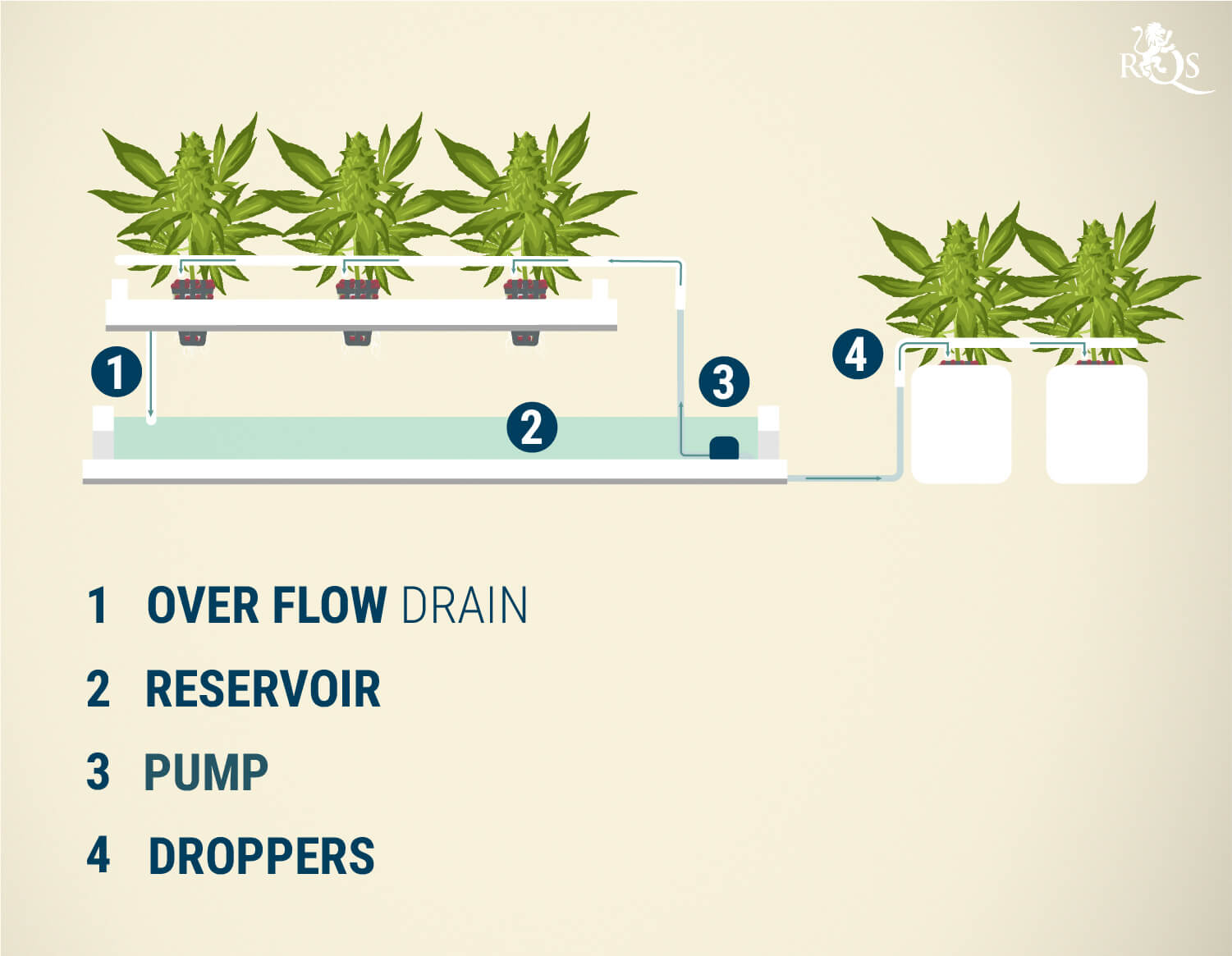
-
Nutrient Film Technique – Diagram
The nutrient film technique features a similar setup to the ebb and flow system. However, instead of occasionally flooding the growing tray, it provides a constant stream of water and nutrient solution to the roots. The reservoir contains an air stone to aerate the solution and an electric water pump to circulate the solution into the growing tray. The growing tray sits at a slight angle to enable the solution to flow downward and back into the reservoir after passing the roots.
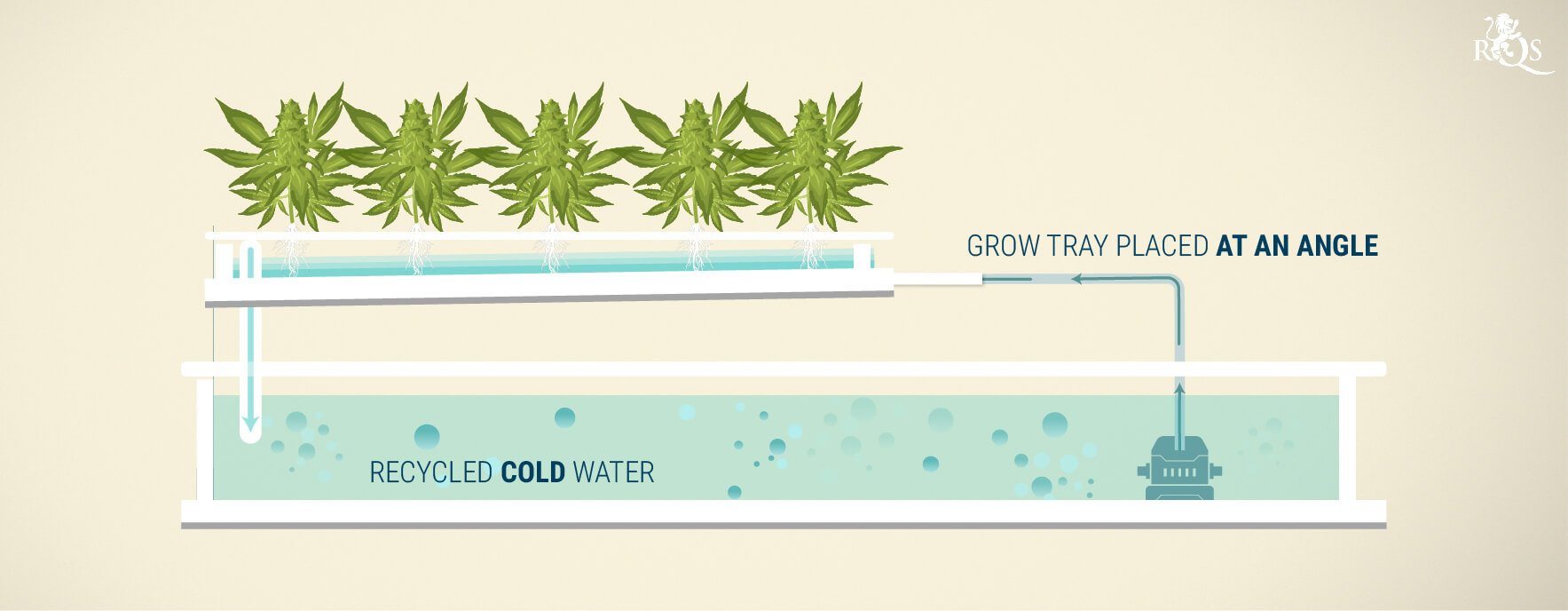

-
Wick System – Diagram
The wick system features a growing container filled with a medium and a separate reservoir that houses the nutrient solution. Some growers choose to fill the growing container with soil, whereas others opt for soilless media such as coco coir. These growing media feature gaps that allow oxygen to enter and aerate the roots—removing the need for an air pump.
Wicks are used to passively transport nutrient solution to the roots. One end sits in the nutrient reservoir and the other in the growing container. Wicks pull water from the reservoir to the roots using capillary action.

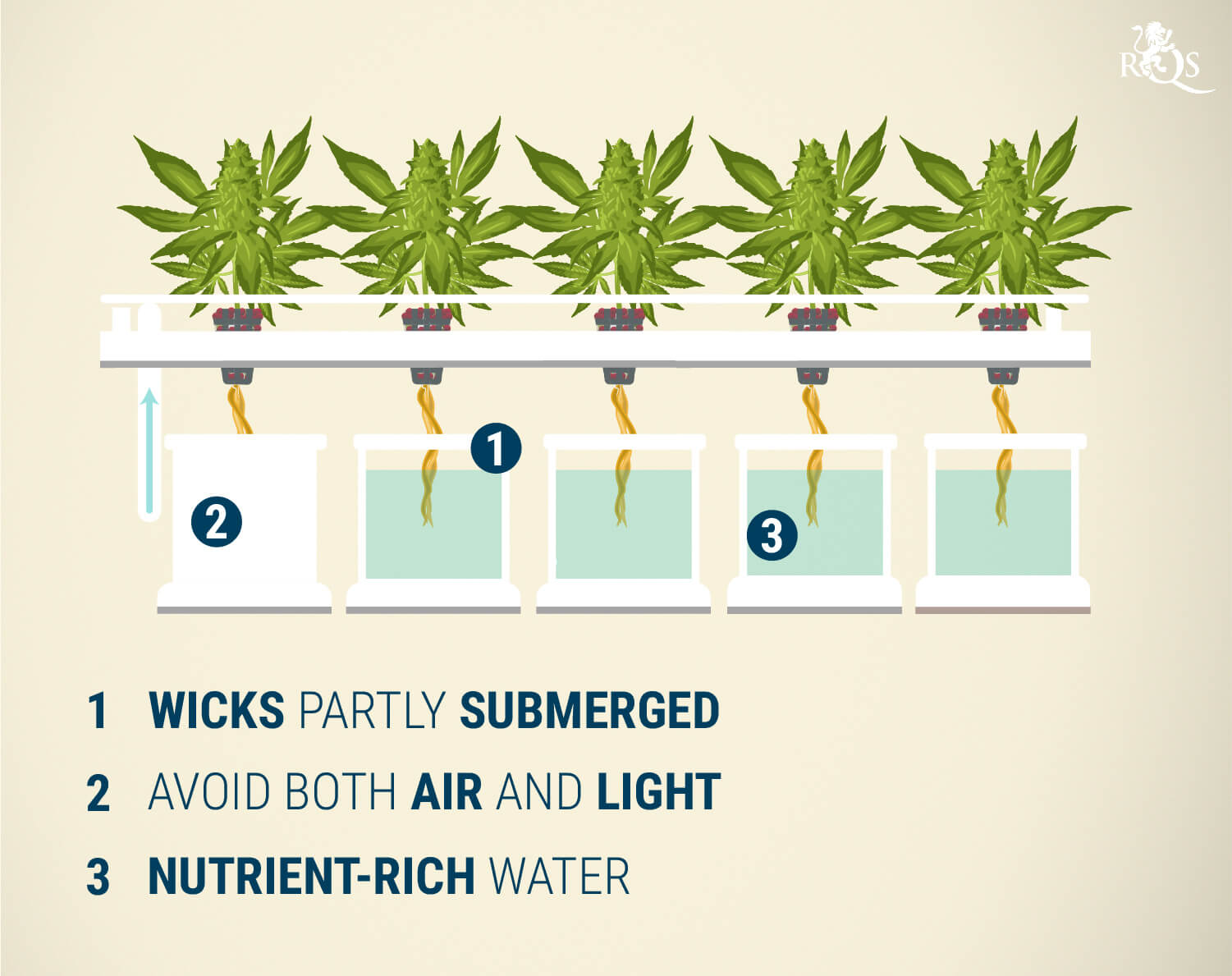
-
Aeroponics – Diagram
Aeroponics is perhaps the most futuristic version of hydroponic growing, and uses misted water dispersed through the air to optimise aeration and hydration. Plants are placed into the top of a large tank of water filling the bottom 25%. Under the water is a pump that sends water into misters underneath the root systems. This fine mist constantly soaks the roots, allowing plants to receive massive quantities of air and water simultaneously.
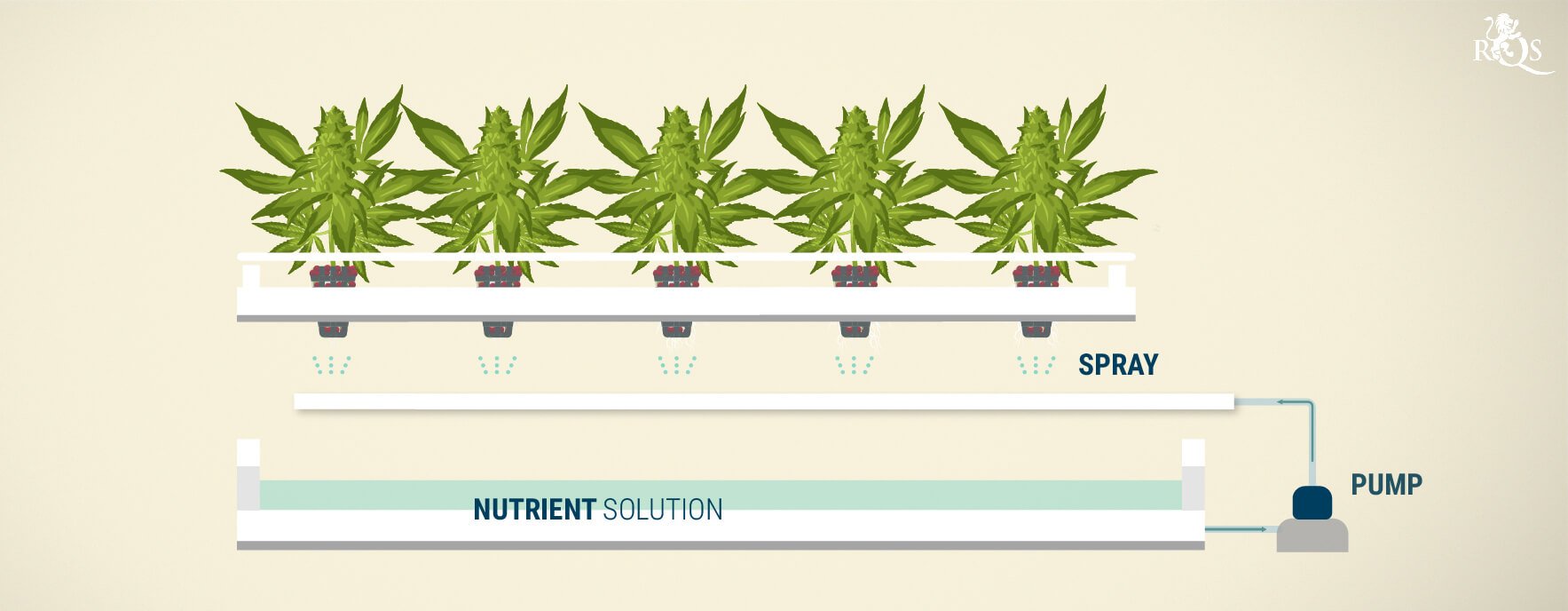
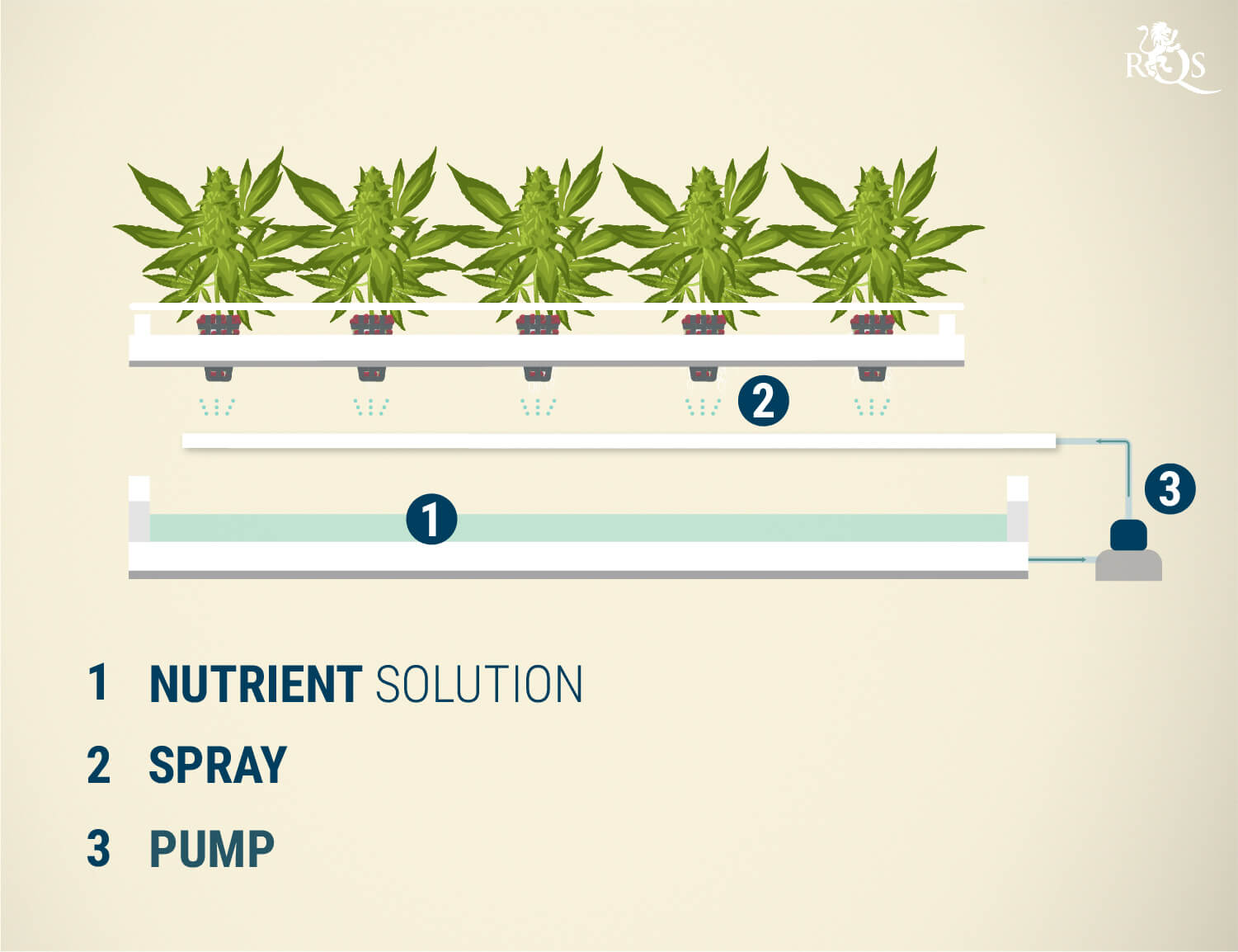
3. Prepare Your System to Ensure a Successful Grow
After choosing your system, it’s important to prepare it well to prevent any detrimental situations. The damp and dark nature of water tanks is an ideal growing environment for a host of pathogens. Before running your system, you will need to sterilise your equipment to minimise the chances of contamination. Wipe down all of your buckets, trays, pipes, and tanks with rubbing alcohol, hot water, and peroxide. Once your system is sterilised, begin following the instructions to set it up correctly.
-
You’ll Need To Maintain Your System Regularly
Every hydroponic system requires frequent maintenance to provide an optimal growing environment. Below are all of the major factors you need to be aware of.
A) Always Monitor pH
You’ll need to constantly test the pH of the water to ensure an optimal growing environment. Nutrients are more available to plants when the environment is slightly more acidic. Therefore, a pH of 5.5–5.8 is required. Use a pH testing kit to take regular readings, and be sure to change the solution weekly to maintain this range. During flowering, a pH of 6 is preferred.
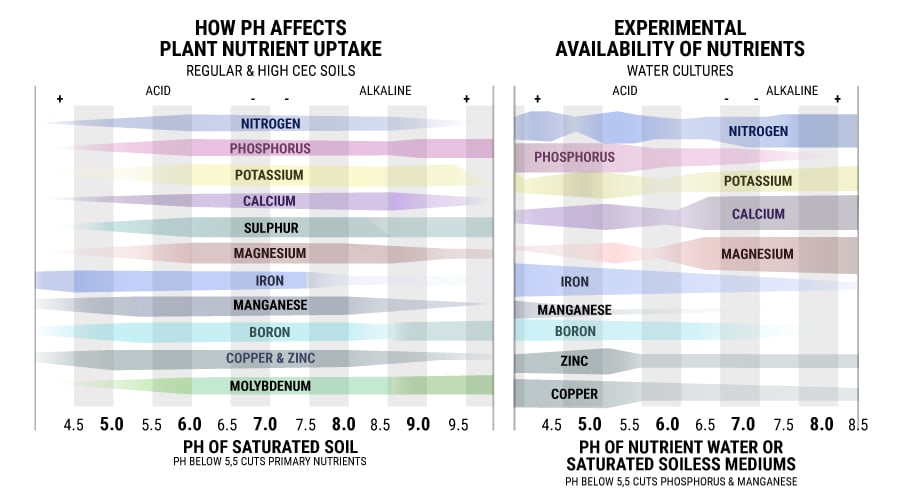

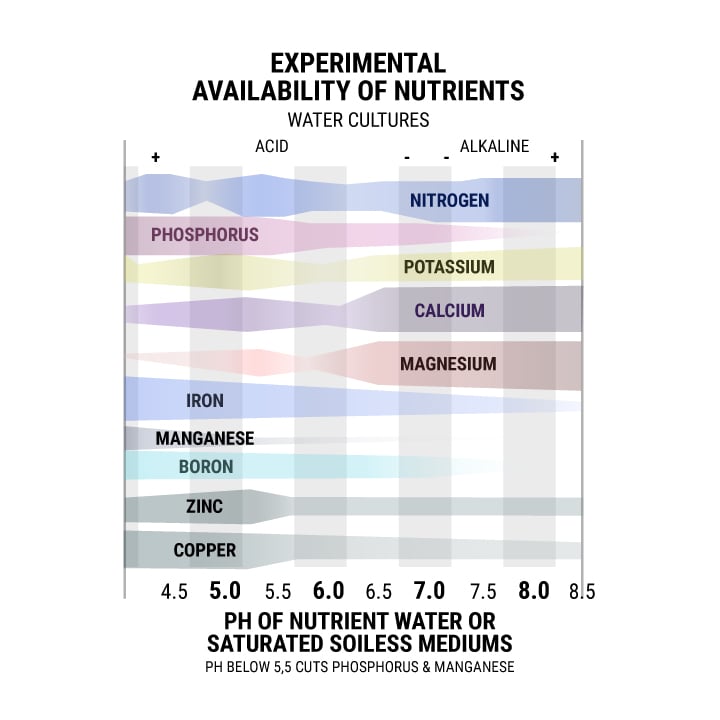
B) Try To Keep Your Water Temperature at Around 20°C
Hydroponic cannabis has an ideal temperature of 20°C. This factor can be monitored using a water thermometer and altered using a water heater if the temperatures are too low.
C) Provide The Correct Quantity Of Nutrients
Hydroponic plants require the same nutrients as their soil-based counterparts. The easiest way to go about feeding your plants is by purchasing hydroponic nutrient solutions that contain all of the required substances for both the vegetation and blooming periods. Products will also describe how often to add nutrients back into your system and how much dilution is required.
D) Keep Things Clean To Avoid Contamination
Both growing trays and tanks require emptying and cleaning around every two weeks. This process will keep the roots of your plants safe against invading pathogens and diseases. Repeat the same process mentioned above when initially preparing your system.
E) Selecting A Strain For Hydroponic Growing
Strain selection is an important factor of hydroponic growing. Plants grown within these systems are free to uptake nutrients extremely fast, which often results in explosive and rapid growth. For this reason, selecting a large, towering sativa variety won't be your best choice, especially if your system resides within an indoor grow tent.
Smaller and more compact strains are ideal for indoor hydroponic systems. Beginning with a smaller strain is advantageous for several reasons. For one, it will let you cultivate several plants within a smaller space, allowing for more diversity and potentially bigger yields. Additionally, if your plants do go through a growth spurt, you'll have room to deal with such sudden surges in height.
Below are two strains that we recommend for hydroponic growing.
-
White Widow
White Widow is a perfectly balanced hybrid strain that features 50% indica genetics and 50% sativa genetics. She was created using parent strain White Widow S1, and provides a well-balanced high that stimulates and excites the mind whilst relaxing and stoning the body. A THC level of 19% ensures a powerful psychoactive experience that lasts several hours. These flowers contain a terpene profile that emanates grounding tastes and smells of earth and pine.
White Widow will reach a height of 60–100cm when grown indoors, making her an ideal candidate for the spatial demands of a hydroponic growing operation. Expect good yields of 450–500g/m² after a flowering period of 8–9 weeks.

White Widow
|
|
White Widow S1 |
|
|
450 - 500 gr/m2 |
|
|
60 - 100 cm |
|
|
8 - 10 weeks |
|
|
THC: 19% |
|
|
Sativa 50% Indica 50% |
|
|
550 - 600 gr/plant |
|
|
150 - 190 cm |
|
|
Early October |
|
|
Powerful , Stoned |
-
Royal Dwarf
Royal Dwarf presents another logical option for an indoor hydroponic setup. This strain combines Skunk and ruderalis with the aim of creating a compact plant capable of good yields and moderate potency. Royal Dwarf is sativa-dominant and offers a motivating and inspiring head high fuelled by a THC level of 13%. Each hit of this strain is infused with tastes of sweetness complemented by notes of citrus.
Expect indoor plants to reach a stealthy height of 40–70cm, produce yields of up to 200g/m², and run from seed to harvest in as little as 8 weeks.

Royal Dwarf
|
|
Skunk x Ruderalis |
|
|
150 - 200 gr/m2 |
|
|
40 - 70 cm |
|
|
6 - 7 weeks |
|
|
THC: 13% |
|
|
Sativa 10% Indica 60% Ruderalis 30% |
|
|
30 - 80 gr/plant |
|
|
50 - 90 cm |
|
|
9 - 10 weeks after sprouting |
|
|
Creative, Motivating |
Hydroponics Can Be Intimidating, But The Reward Is Worth It
Hydroponics can seem scary and complicated to the outside observer. All of the different parts, systems, and methods make the subject seem very complex. The key is to start out simple, choose an appropriate strain, and observe your plants' environmental needs frequently. Growing in a hydroponic setup is very rewarding, and the work pays off with rapid growth times and large yields.
The thought of starting out in hydroponics is scary but it can be done. In fact, it is much easier than it seems. Hopefully this guide will be helpful in setting up and maintaining your hydroponics system.
 Grow Guide Topic Finder
Grow Guide Topic Finder
- Growing weed step by step
- Cannabis growing basics
- Choosing your seeds
- How to germinate seeds
- The cannabis vegetative stage
- The cannabis flowering stage
- Harvesting cannabis
- Trimming, drying, and curing
- Choosing pots and soil
-
Growing indoors
- A Complete Overview Of Growing Cannabis Indoors
- Cannabis Cultivation Tips: How To Set Up Indoor Grow Lights
- How Many Cannabis Plants Can You Grow Per Square Metre?
- Indoor Cannabis Growing: Relative Humidity and Temperatures
- Hydroponics Cannabis Growing Guide (with diagrams)
- Cannabis Micro Growing: Growing Great Weed in Tiny Spaces
- Growing outdoors
- How to grow autoflowering cannabis
- Cannabis nutrients and pH
- Cannabis troubleshooting: Nutrients
-
Cannabis troubleshooting: Growing
- Cannabis Seed Germination — Troubleshooting Guide
- How to Deal With Pythium (Root Rot) in Cannabis Plants
- Slow Cannabis Plant Growth And What You Can Do About It
- How to Prevent and Fix Stretching in Cannabis Seedlings
- Watering Your Cannabis: How to Fix Overwatering and Underwatering
- Understanding Male, Female, And Hermaphrodite Cannabis
- Identifying and Treating Common Cannabis Ailments
- How To Revive a Sick Cannabis Plant
- How to Avoid Mouldy Weed During Drying and Curing
- How to Prevent and Treat Dry and Crispy Cannabis Leaves
- What Cannabis Leaves Can Tell You
- Causes and Solutions for Yellow Cannabis Leaves
-
Cannabis Strains Grow Report
- HulkBerry Automatic Grow Report
- Blue Cheese Auto Grow Report
- Purple Punch Automatic Grow Report
- Triple G Automatic Grow Report
- Do-Si-Dos Automatic Grow Report
- Green Gelato Automatic Grow Report
- Haze Berry Automatic Grow Report
- Purple Queen Automatic Grow Report
- Cookies Gelato Automatic Grow Report
- Sherbet Queen Automatic Grow Report
- Sweet Skunk Automatic Grow Report
- Medusa F1 Grow Report
- Cannabis plant training
-
Weed growing tips
- The Cannabis Plant Anatomy
- How to preserve seeds
- How Much Sunlight Do Outdoor Cannabis Plants Need To Grow?
- How to Control and Prevent Stretching in Cannabis Plants
- My Cannabis Plants Are Growing Too Tall: What Should I Do?
- Should You Worry About Purple Or Red Cannabis Stems?
- What To Do When Your Indoor Cannabis Won’t Flower
- How To Protect Your Cannabis Plants From Heat Stress
- How To Tell If Your Female Cannabis Plant Has Been Pollinated
- Growing Medical Marijuana
- Bud Washing: How to Clean Your Weed
- Understanding Cannabis Yield per Plant






























